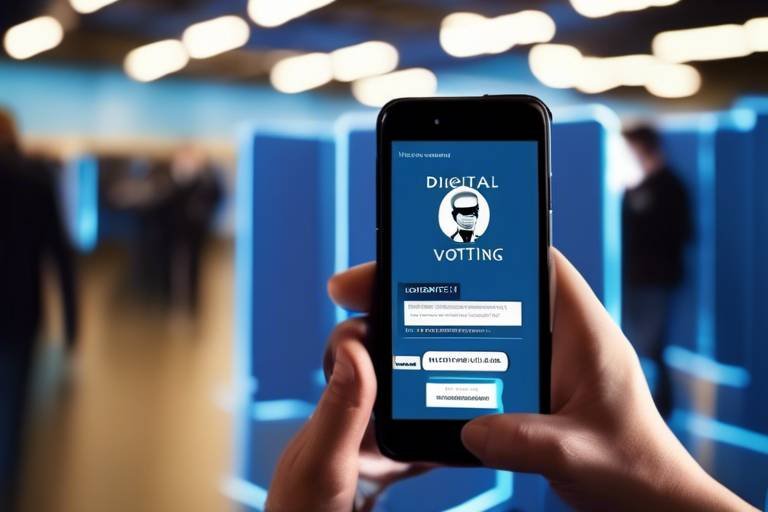Understanding the Challenges of Scaling Blockchain Solutions
In the rapidly evolving world of technology, blockchain stands out as a revolutionary force, promising to reshape industries from finance to supply chain management. However, as organizations rush to adopt this technology, they often encounter a series of complex challenges that can hinder its scalability. Scaling blockchain solutions is not just about increasing transaction throughput; it involves navigating a labyrinth of technical, economic, and regulatory hurdles. So, what does it really take to scale blockchain effectively? Let’s dive into the intricacies of this multifaceted issue.
At the heart of blockchain scalability issues lie technical limitations that can significantly impact performance. One of the most pressing concerns is transaction speed. As more users join a blockchain network, the number of transactions increases, leading to potential network congestion. This congestion can result in slower transaction times and higher fees, ultimately deterring users from utilizing the platform. Additionally, data storage concerns arise as the blockchain grows, requiring innovative solutions to manage and archive vast amounts of data efficiently.
Understanding these constraints is crucial for developers aiming to create effective scaling strategies. For instance, a blockchain that can only process a limited number of transactions per second will struggle to compete with traditional payment systems like Visa or Mastercard, which can handle thousands of transactions in the same timeframe. As such, addressing these technical limitations is not merely an option; it is a necessity for achieving widespread adoption.
Another layer of complexity in scaling blockchain solutions lies in the various consensus mechanisms employed. These mechanisms, which are essential for maintaining the integrity and security of the blockchain, can either facilitate or hinder scalability. For example, Proof of Work (PoW), the consensus mechanism used by Bitcoin, is known for its security but is often criticized for its high energy consumption and slower transaction speeds. On the other hand, Proof of Stake (PoS) offers a more energy-efficient alternative that can potentially enhance scalability.
When comparing these two popular consensus mechanisms, it's evident that each has its own strengths and weaknesses. PoW is robust and secure but can struggle with scalability due to its resource-intensive nature. In contrast, PoS allows for faster transactions and lower energy usage, but it raises questions about centralization and security. Developers must weigh these factors carefully to choose the best approach for their projects.
Exploring hybrid consensus models may provide a balanced solution that combines the strengths of both PoW and PoS. By leveraging the security of PoW while enjoying the efficiency of PoS, hybrid models can offer innovative approaches to overcoming the limitations of traditional mechanisms.
New consensus algorithms, such as Delegated Proof of Stake and Practical Byzantine Fault Tolerance, are emerging as potential solutions to scalability challenges. Each of these alternatives presents unique attributes and trade-offs, making them worthy of consideration for developers looking to optimize blockchain performance.
In addition to consensus mechanisms, Layer 2 solutions like state channels and sidechains are gaining traction as effective ways to enhance blockchain scalability. These solutions allow for offloading transactions from the main chain, reducing congestion while maintaining security and decentralization. By implementing Layer 2 solutions, developers can significantly increase transaction throughput without compromising on the core principles of blockchain technology.
Economic factors play a significant role in the scalability of blockchain solutions. The design of tokenomics can significantly influence user behavior and network growth. A well-structured economic model can drive participation and investment in scaling initiatives, ensuring that the network remains vibrant and engaged.
Access to funding and investment is crucial for scaling blockchain projects. Developers often face financial challenges that can impede their ability to innovate and expand. Understanding the various funding options available—ranging from venture capital to crowdfunding—can open doors to new opportunities in the blockchain ecosystem.
Regulatory hurdles can also impede the scalability of blockchain solutions. The legal landscape surrounding blockchain technology is constantly evolving, and understanding these regulations is essential for navigating compliance and fostering innovation. Different jurisdictions have varying regulations regarding blockchain, making it challenging for developers to create solutions that are compliant on a global scale.
Creating a blockchain solution that adheres to global compliance standards can be a daunting task. Developers must stay informed about the regulatory requirements in different regions to ensure their projects can operate smoothly across borders.
Data privacy laws, such as the General Data Protection Regulation (GDPR), pose significant challenges for blockchain scalability. Developers must find ways to balance transparency with user privacy and data protection, which can complicate the design of blockchain systems. This balancing act is crucial for maintaining user trust while still adhering to legal requirements.
- What are the main challenges in scaling blockchain technology?
The main challenges include technical limitations, consensus mechanisms, economic incentives, and regulatory hurdles.
- How do consensus mechanisms affect scalability?
Consensus mechanisms determine how transactions are validated and can significantly impact transaction speed and network efficiency.
- What are Layer 2 solutions?
Layer 2 solutions are protocols built on top of a blockchain that enable faster transactions by offloading some of the transaction load from the main chain.
- Why is regulatory compliance important for blockchain projects?
Regulatory compliance ensures that blockchain projects can operate legally in different jurisdictions, which is essential for their long-term success.

Technical Limitations
Scaling blockchain solutions often encounters a variety of that can hinder performance and user experience. One of the most significant challenges is transaction speed. In a world where instant gratification is the norm, users expect transactions to be processed in the blink of an eye. However, many blockchain networks struggle with this, leading to delays and frustration. Imagine waiting in a long line at a coffee shop when all you want is your morning caffeine fix—this is the reality for blockchain users when transaction times lag.
Another critical issue is network congestion. As more users flock to a blockchain platform, the network can become overwhelmed, resulting in slower transaction processing times and higher fees. For instance, during peak periods, such as when a popular NFT drops, the network can experience a surge in demand that it simply cannot handle. This congestion can create a bottleneck effect, causing users to abandon transactions altogether. In essence, it's like a traffic jam on a highway where everyone is trying to get to the same destination at once.
Data storage is also a significant hurdle. Blockchains are designed to be immutable and transparent, which means that every transaction must be recorded permanently. Over time, this can lead to massive amounts of data that need to be stored and managed effectively. When the size of the blockchain grows, it can become cumbersome for nodes to maintain a complete copy of the ledger. This situation poses a challenge for scalability, as the larger the blockchain, the more resources are required to operate it. It's akin to trying to fit a growing library into a small room—eventually, space becomes a critical issue.
To tackle these technical limitations, developers must understand the constraints of their chosen blockchain technology. Some strategies may include optimizing the block size, implementing sharding to distribute data across multiple nodes, or adopting innovative consensus mechanisms that can handle higher transaction volumes. Each of these approaches has its own set of trade-offs, and finding the right balance is crucial for successful scaling.
In conclusion, the technical limitations of blockchain technology present a complex landscape that developers must navigate. By addressing issues like transaction speed, network congestion, and data storage, the blockchain community can work towards creating solutions that enhance scalability and improve user experience. The journey may be challenging, but with the right strategies in place, the potential for widespread adoption remains bright.

Consensus Mechanisms
When it comes to scaling blockchain solutions, one of the most critical aspects to consider is the consensus mechanism. This is the method by which a blockchain network agrees on the validity of transactions and the state of the ledger. Different consensus mechanisms can dramatically influence the scalability of a blockchain, impacting everything from transaction speed to energy consumption. For instance, traditional methods like Proof of Work (PoW) and Proof of Stake (PoS) each come with their own sets of advantages and challenges that can either facilitate or hinder the adoption of blockchain technology.
Let's dive deeper into how these mechanisms work. Proof of Work, which is employed by Bitcoin, requires participants (miners) to solve complex mathematical problems to validate transactions. This process, while secure, is notoriously energy-intensive and can lead to network congestion, especially during peak times. On the other hand, Proof of Stake allows validators to create new blocks based on the number of coins they hold and are willing to "stake" as collateral. This method is generally more energy-efficient and can process transactions much faster, but it raises questions about wealth concentration and centralization.
To better understand the differences between PoW and PoS, let’s break it down in a comparative table:
| Feature | Proof of Work | Proof of Stake |
|---|---|---|
| Energy Consumption | High | Low |
| Transaction Speed | Slower | Faster |
| Security | Very Secure | Secure but less tested |
| Decentralization | Highly Decentralized | Can lead to centralization |
As you can see, the choice between PoW and PoS can significantly impact the scalability of a blockchain project. Developers must weigh these factors carefully to determine which mechanism aligns best with their specific needs and goals. In some cases, hybrid models that combine elements of both consensus types can provide a balanced solution, enhancing both scalability and security.
Speaking of hybrid models, these innovative approaches are gaining traction as developers seek to overcome the limitations of traditional consensus mechanisms. By blending the strengths of PoW and PoS, hybrid models can offer a unique balance that promotes both decentralization and efficiency. Imagine driving a car that uses both electric and gasoline power; you get the best of both worlds—environmental friendliness and speed. Similarly, hybrid consensus models can optimize performance while maintaining robust security protocols.
In addition to hybrid models, new consensus algorithms are emerging as potential solutions to scalability challenges. For example, Delegated Proof of Stake (DPoS) allows stakeholders to elect a small number of delegates to validate transactions on their behalf, significantly speeding up the process. Another promising approach is Practical Byzantine Fault Tolerance (PBFT), which focuses on achieving consensus in a more efficient manner, especially in private or permissioned blockchain networks. Each of these alternatives comes with its own unique attributes and trade-offs, making it essential for developers to stay informed about the latest innovations in the field.
In conclusion, understanding the various consensus mechanisms is crucial for anyone looking to scale blockchain solutions effectively. The choice of mechanism not only affects transaction speed and energy consumption but also plays a significant role in the overall decentralization and security of the network. As the blockchain landscape continues to evolve, staying abreast of these developments will be key for developers and organizations aiming for widespread adoption.

Proof of Work vs. Proof of Stake
When it comes to blockchain technology, the debate between Proof of Work (PoW) and Proof of Stake (PoS) is akin to the classic rivalry of the tortoise and the hare. Each has its own merits and drawbacks, and understanding these can be crucial for developers aiming to optimize scalability. Let's dive into the details!
Proof of Work is the original consensus mechanism used by Bitcoin and many other cryptocurrencies. It operates on a simple premise: miners solve complex mathematical puzzles to validate transactions and add them to the blockchain. This process is resource-intensive and requires significant computational power, leading to concerns about its energy consumption. The more miners there are, the more secure the network becomes, but at the cost of speed and efficiency. Imagine a crowded highway where every car (or miner) is trying to reach the same destination; traffic jams and delays are inevitable!
On the other hand, Proof of Stake shifts the paradigm. Instead of relying on computational power, PoS allows validators to create new blocks based on the number of coins they hold and are willing to "stake" as collateral. This method is far less energy-intensive, akin to a well-organized carpool where fewer vehicles are needed to reach the same destination efficiently. However, while PoS can significantly enhance transaction speed and reduce energy consumption, it raises questions about centralization. Wealthier participants may have more influence over the network, potentially leading to a system where the rich get richer.
To clarify the differences, let's take a look at the following table:
| Feature | Proof of Work (PoW) | Proof of Stake (PoS) |
|---|---|---|
| Energy Consumption | High | Low |
| Transaction Speed | Slower | Faster |
| Security | Highly secure but vulnerable to 51% attacks | Less secure if wealth is concentrated |
| Incentives | Rewards for mining | Rewards for staking |
As we can see, both mechanisms have their strengths and weaknesses. Developers must weigh these factors carefully when choosing a consensus model for their blockchain projects. For instance, if a project prioritizes environmental sustainability, PoS might be the way to go. However, if security is paramount, PoW could provide the robustness needed to deter malicious actors.
In conclusion, whether you lean towards Proof of Work or Proof of Stake, the ultimate goal remains the same: to create a scalable, secure, and efficient blockchain solution. The choice between these two mechanisms can significantly impact the performance and adoption of blockchain technology, making it essential for developers to understand the implications of their decisions.
- What is the main difference between PoW and PoS? The primary difference lies in how they validate transactions: PoW relies on computational power, while PoS uses the amount of cryptocurrency held by validators.
- Which is more environmentally friendly? Proof of Stake is generally considered more eco-friendly due to its lower energy consumption compared to Proof of Work.
- Can PoW and PoS be combined? Yes, some blockchains are exploring hybrid models that incorporate both PoW and PoS to leverage the strengths of each mechanism.

Hybrid Models
In the ever-evolving landscape of blockchain technology, have emerged as a beacon of hope for overcoming the limitations posed by traditional consensus mechanisms. These innovative approaches combine the best features of both Proof of Work (PoW) and Proof of Stake (PoS), aiming to strike a balance between scalability and security. Imagine a world where the energy-intensive nature of PoW is mitigated by the efficiency of PoS, creating a system that is not only robust but also environmentally friendly.
Hybrid models operate on the premise that no single consensus mechanism can effectively address all the challenges inherent in blockchain technology. By integrating multiple mechanisms, developers can tailor solutions to specific use cases, enhancing overall performance. For instance, a hybrid approach might utilize PoW for validating critical transactions while employing PoS for regular activities, thereby optimizing resource allocation and improving transaction speeds.
One of the most compelling aspects of hybrid models is their flexibility. They can be designed to adapt to varying network conditions, ensuring that the blockchain remains efficient even under heavy load. Consider the following benefits of hybrid models:
- Increased Scalability: By distributing the workload across different consensus methods, hybrid models can handle a higher volume of transactions.
- Enhanced Security: Combining the security features of PoW and PoS can create a more resilient network against attacks.
- Energy Efficiency: Reducing reliance on energy-intensive processes helps address environmental concerns associated with blockchain technology.
However, the implementation of hybrid models is not without its challenges. Developers must navigate the complexities of integrating different consensus mechanisms, ensuring they work harmoniously without compromising the network's integrity. Additionally, the governance structures of hybrid systems can become convoluted, leading to potential conflicts among stakeholders.
Despite these challenges, the potential of hybrid models is immense. They offer a pathway for blockchain networks to evolve and adapt to the demands of a rapidly changing digital landscape. As more projects explore these innovative solutions, we may witness a significant shift in how blockchain technology is perceived and utilized across various industries.
What are hybrid models in blockchain?
Hybrid models in blockchain refer to systems that combine different consensus mechanisms, such as Proof of Work and Proof of Stake, to enhance scalability and security.
How do hybrid models improve scalability?
By distributing transaction validation across multiple consensus methods, hybrid models can handle more transactions simultaneously, reducing bottlenecks and improving overall network performance.
What are the challenges of implementing hybrid models?
Integrating different consensus mechanisms can be complex, and governance structures may become convoluted, leading to potential conflicts among stakeholders.
Are hybrid models environmentally friendly?
Yes, by reducing reliance on energy-intensive processes like Proof of Work, hybrid models can help address environmental concerns associated with traditional blockchain technologies.

Emerging Alternatives
As the blockchain landscape continues to evolve, to traditional consensus mechanisms are gaining traction. These new algorithms aim to address the scalability challenges faced by existing systems while maintaining security and decentralization. One notable example is Delegated Proof of Stake (DPoS), which allows token holders to elect delegates responsible for validating transactions. This method not only increases transaction throughput but also reduces the energy consumption typically associated with Proof of Work (PoW) systems.
Another promising alternative is Practical Byzantine Fault Tolerance (PBFT). This consensus mechanism is designed to provide high transaction speeds and finality, making it particularly suitable for private and consortium blockchains. By allowing nodes to reach consensus even in the presence of faulty or malicious nodes, PBFT enhances the reliability of the network. However, it does come with its own set of trade-offs, such as a limited scalability in highly decentralized environments.
To illustrate the differences between these emerging alternatives and traditional mechanisms, consider the following table:
| Consensus Mechanism | Scalability | Energy Efficiency | Security |
|---|---|---|---|
| Proof of Work | Low | Low | High |
| Proof of Stake | Medium | Medium | Medium |
| Delegated Proof of Stake | High | High | Medium |
| Practical Byzantine Fault Tolerance | Medium | High | High |
These alternatives not only offer solutions to scalability issues but also introduce unique attributes that can benefit specific use cases. For instance, DPoS is particularly effective for applications requiring rapid transaction confirmations, such as decentralized exchanges or gaming platforms. On the other hand, PBFT might be more suitable for enterprise applications where speed and reliability are critical.
As we look to the future, the ongoing research and development in blockchain technology will likely yield even more innovative consensus algorithms. These emerging alternatives are not just theoretical; they represent a shift towards a more scalable and efficient blockchain ecosystem that can support a wider range of applications. The potential for these technologies to revolutionize how we think about decentralization and transaction processing is immense, making them a key area to watch in the coming years.
- What is the main advantage of using Delegated Proof of Stake?
Delegated Proof of Stake offers improved scalability and energy efficiency compared to traditional Proof of Work systems, making it ideal for applications requiring high transaction throughput. - How does Practical Byzantine Fault Tolerance enhance security?
PBFT allows a network to achieve consensus even when some nodes are faulty or malicious, thus providing a robust layer of security for transactions. - Are these emerging alternatives widely adopted?
While still in the early stages of adoption, emerging alternatives like DPoS and PBFT are being implemented in various projects and show promising results in terms of scalability and efficiency.

Layer 2 Solutions
When we talk about scaling blockchain technology, one of the most exciting developments is the emergence of . These are innovative frameworks designed to handle transactions off the main blockchain, allowing for significantly faster processing times while still maintaining the core principles of decentralization and security. Think of Layer 2 solutions as a bustling highway that alleviates traffic from the main road, enabling smoother and quicker travel. By offloading transactions from the main chain, these solutions can help reduce congestion and improve overall network performance.
One of the most well-known Layer 2 solutions is the concept of state channels. State channels allow two or more parties to transact off-chain, only settling the final outcome on the main blockchain. This drastically reduces the number of transactions that need to be processed on-chain, which in turn enhances speed and lowers costs. Imagine playing a board game where you only need to record the final score instead of every single move; that's the efficiency state channels bring to blockchain transactions.
Another promising Layer 2 solution is sidechains. A sidechain operates parallel to the main blockchain and can process transactions independently. This means that if the main chain is congested, transactions can still occur on the sidechain without any delays. Once the transactions are completed, they can be bundled and sent back to the main chain. This flexibility is akin to having multiple lanes in a highway system, where traffic can be diverted to less busy routes without affecting the overall flow.
However, while Layer 2 solutions offer many advantages, they also come with their own set of challenges. The primary concern is ensuring security and trust in these off-chain solutions. After all, if the main chain is the foundation of trust, how do we ensure that transactions processed off-chain are equally secure? Developers are continuously working on protocols to address these concerns, and innovations such as zero-knowledge proofs are paving the way for more secure Layer 2 solutions.
In summary, Layer 2 solutions represent a significant leap forward in enhancing the scalability of blockchain networks. By enabling faster transactions and reducing congestion, they are essential for the widespread adoption of blockchain technology. As we continue to explore these solutions, it’s clear that they hold the key to unlocking the full potential of blockchain applications.
- What are Layer 2 solutions?
Layer 2 solutions are protocols built on top of a blockchain network that help improve scalability by processing transactions off the main chain. - How do state channels work?
State channels allow participants to transact off-chain, recording only the final outcome on the blockchain, which reduces on-chain transaction load. - What are the benefits of using sidechains?
Sidechains operate independently of the main blockchain, allowing for faster transactions and less congestion while still being able to settle back to the main chain. - Are Layer 2 solutions secure?
While they offer many advantages, security is a concern. Developers are working on various protocols to ensure that off-chain transactions are secure and trustworthy.

Economic Incentives
When it comes to scaling blockchain solutions, economic factors play a crucial role that cannot be overlooked. The success of any blockchain initiative often hinges on the incentives it offers to participants. These incentives are not just about financial rewards; they encompass a broad spectrum of motivations that drive user engagement and investment in the technology. For instance, when developers design a blockchain network, they need to consider how to encourage users to participate actively in the ecosystem. This can be achieved through various means, such as rewarding users with tokens for their contributions or providing them with exclusive access to certain features.
One of the most effective ways to enhance scalability is through tokenomics, which refers to the economic model that governs the distribution and value of tokens within the blockchain ecosystem. A well-designed tokenomics structure can significantly influence user behavior, encouraging them to hold, trade, or utilize tokens in ways that promote network growth. For example, if users are rewarded for staking their tokens, they are more likely to participate in the network's operations, thereby enhancing its overall performance and scalability.
Moreover, access to funding and investment is another pivotal economic factor that influences the scalability of blockchain projects. Developers often face challenges in securing the necessary capital to scale their initiatives effectively. This is where venture capital, crowdfunding, and institutional investments come into play. The blockchain ecosystem is ripe with opportunities for investors, but developers must present a compelling case for why their project deserves funding. This involves demonstrating not only the potential for profit but also how their solution addresses real-world problems and offers unique value propositions.
To illustrate the relationship between economic incentives and blockchain scalability, consider the following table:
| Incentive Type | Description | Impact on Scalability |
|---|---|---|
| Token Rewards | Users earn tokens for participating in the network | Encourages user engagement and network growth |
| Staking | Users lock their tokens to support network operations | Enhances security and incentivizes long-term holding |
| Access to Features | Exclusive features for token holders | Promotes token utility and drives demand |
| Investment Opportunities | Funding from investors to support development | Facilitates scaling through financial resources |
In conclusion, understanding the economic incentives that drive participation in blockchain networks is essential for developers aiming to scale their solutions effectively. By creating a robust tokenomics model and securing adequate funding, blockchain projects can not only attract users but also foster a thriving ecosystem that supports scalability. As the blockchain landscape continues to evolve, those who can navigate these economic challenges will be well-positioned to lead the charge in innovation and adoption.
- What are economic incentives in blockchain? Economic incentives are motivations that encourage users to participate in blockchain networks, often through rewards or benefits.
- How does tokenomics influence blockchain scalability? Tokenomics affects user behavior and network growth, impacting how effectively a blockchain can scale.
- What role does funding play in scaling blockchain projects? Access to funding is crucial for developers to implement their projects and scale effectively.

Tokenomics
When we talk about , we're diving into the fascinating world of how tokens are structured and utilized within blockchain ecosystems. It's not just about creating a digital coin; it's about understanding how these tokens can incentivize behavior, drive network growth, and ultimately affect the scalability of blockchain applications. Imagine you’re at a party where everyone is trying to get a piece of the cake. The more enticing the cake looks (or in this case, the tokenomics), the more people will want to join in and grab a slice. That’s the essence of effective tokenomics!
At its core, tokenomics encompasses several critical elements, including distribution models, utility, and incentive structures. Each of these factors plays a pivotal role in determining how users interact with the blockchain and how the network evolves over time. For instance, a well-thought-out distribution model can ensure that tokens are spread out evenly, preventing centralization and encouraging broader participation. Conversely, if too few people hold too many tokens, the network may become stagnant, limiting its scalability.
Moreover, the utility of tokens is another crucial aspect. Tokens can serve various purposes, such as granting access to services, facilitating transactions, or even acting as governance tools. This utility can significantly influence user engagement. If users see clear benefits to holding or using a token, they are more likely to participate, which can lead to a vibrant, scalable ecosystem. Think of it like a video game: the more rewards you offer players for completing tasks, the more they want to play!
In addition to distribution and utility, the incentive structures behind tokenomics can drive significant network growth. By aligning the interests of users with those of the network, developers can create a self-sustaining ecosystem. For example, offering rewards for staking tokens or participating in governance can motivate users to engage more deeply with the platform. This engagement can lead to increased transaction volumes and, consequently, a more scalable blockchain solution.
To illustrate the impact of tokenomics on scalability, let’s take a look at a simple table summarizing key aspects:
| Aspect | Impact on Scalability |
|---|---|
| Distribution Model | Ensures decentralization, preventing bottlenecks and encouraging participation. |
| Utility | Increases user engagement, leading to higher transaction volumes. |
| Incentive Structures | Aligns user interests with network goals, fostering a self-sustaining ecosystem. |
In summary, understanding tokenomics is essential for anyone looking to scale blockchain solutions effectively. It’s not just about creating a digital currency; it’s about crafting an ecosystem where users feel valued and motivated to participate. When done right, tokenomics can be the secret sauce that transforms a fledgling blockchain project into a thriving, scalable network. So, the next time you're pondering over a blockchain project, remember: the key to unlocking its potential lies in the intricacies of its tokenomics!
Q1: What is tokenomics?
A1: Tokenomics refers to the economic model behind a cryptocurrency or token, including its distribution, utility, and incentive structures that influence user behavior and network growth.
Q2: Why is tokenomics important for scalability?
A2: Effective tokenomics can drive user engagement, promote decentralization, and encourage participation, all of which are crucial for achieving scalability in blockchain solutions.
Q3: How do incentive structures work in tokenomics?
A3: Incentive structures align the interests of users with those of the network, motivating them to participate in activities like staking or governance, which can enhance the network's scalability.

Funding and Investment
When it comes to scaling blockchain projects, are like the fuel that keeps the engine running. Without adequate financial backing, even the most innovative ideas can fizzle out before they ever reach the market. But why is funding so crucial? Well, think of it this way: developing a blockchain solution is not just about writing code; it involves extensive research, testing, and implementation. All of these stages require significant resources, both in terms of time and money.
Many developers face the daunting challenge of securing venture capital or other forms of investment. The landscape can be competitive, and investors often have a plethora of options to choose from. They are looking for projects that not only promise high returns but also demonstrate a clear path to scalability and adoption. This means that developers need to articulate their vision effectively, showcasing how their blockchain solution stands out from the crowd.
Moreover, the blockchain ecosystem is still relatively young, which adds another layer of complexity. Investors may be hesitant to dive into projects that lack proven track records or established user bases. This is where a well-structured pitch and a solid business plan come into play. Developers must highlight their unique value propositions and how their projects can overcome existing challenges in the market.
In addition to traditional funding routes, many blockchain projects are turning to initial coin offerings (ICOs) and token sales as alternative methods to raise capital. These approaches allow developers to sell tokens directly to investors, often providing them with a stake in the project’s future success. However, navigating the regulatory landscape for ICOs can be tricky, as different jurisdictions have varying rules regarding securities and crowdfunding.
To give you a clearer picture, let’s take a look at some common funding avenues for blockchain projects:
| Funding Type | Description | Pros | Cons |
|---|---|---|---|
| Venture Capital | Investment from firms that specialize in funding startups. | Access to expertise and networks. | May require equity stakes. |
| ICO/Token Sale | Raising funds by selling tokens to the public. | Direct access to a large pool of investors. | Regulatory scrutiny and market volatility. |
| Grants | Non-repayable funds provided by organizations or governments. | No equity loss. | Highly competitive and often specific to certain projects. |
Ultimately, the journey of securing funding is not just about the money; it's about building relationships and trust within the blockchain community. Developers who can effectively communicate their vision and demonstrate a commitment to innovation are more likely to attract the right investors. And as the blockchain space continues to evolve, those who adapt and find creative funding solutions will be the ones to thrive.
- What are the main sources of funding for blockchain projects? Common sources include venture capital, ICOs, grants, and crowdfunding.
- How can I attract investors to my blockchain project? Create a solid business plan, showcase your unique value proposition, and build a strong network.
- What are the risks associated with ICOs? ICOs can face regulatory challenges and market volatility, which may affect the project's success.
- Can I get funding without giving up equity? Yes, grants and certain crowdfunding models allow you to raise funds without equity loss.

Regulatory Challenges
When it comes to scaling blockchain solutions, one of the most significant hurdles developers face are . The landscape of blockchain regulation is a complex maze, often shifting and evolving. This complexity can create significant barriers for developers looking to innovate and expand their applications across borders. For instance, different jurisdictions have their own sets of rules and regulations that govern the use of blockchain technology, making it a daunting task to ensure compliance globally. Imagine trying to navigate a minefield blindfolded; that’s how it feels for many in the blockchain space.
To illustrate this point, consider the following key regulatory challenges:
- Varying Regulations: Each country has its own approach to blockchain regulation. Some may embrace it, while others impose strict restrictions. This inconsistency can stifle innovation and delay project launches.
- Legal Classification: Determining whether a blockchain token is a security, utility, or something else entirely can be a legal quagmire. Misclassification can lead to severe penalties and legal issues.
- Compliance Costs: Ensuring compliance with regulations often comes with hefty costs. These expenses can drain resources from projects, particularly startups that are already operating on tight budgets.
Moreover, the rise of decentralized finance (DeFi) and non-fungible tokens (NFTs) has further complicated the regulatory landscape. With these innovations, regulators are scrambling to catch up, often resulting in overreaching regulations that can stifle creativity and limit the potential of blockchain technology. For example, if a DeFi platform operates in multiple countries, it must navigate a patchwork of regulations that can change from one jurisdiction to another. This can lead to uncertainty and hesitation from investors and developers alike.
Another crucial aspect to consider is the impact of data privacy regulations. Laws like the General Data Protection Regulation (GDPR) in Europe impose strict guidelines on how personal data is collected and stored. Blockchain's inherent transparency conflicts with these privacy laws, creating a tension that developers must carefully manage. The challenge lies in finding a balance between the transparency that blockchain offers and the privacy that users demand. This balancing act can be likened to walking a tightrope, where one misstep could lead to significant legal repercussions.
In conclusion, while the potential of blockchain technology is immense, the regulatory challenges it faces cannot be overlooked. Developers must remain vigilant and informed about the legal landscape to ensure that their projects not only thrive but also comply with necessary regulations. As the blockchain ecosystem continues to grow, fostering a collaborative dialogue between developers and regulators will be essential for paving the way toward a more innovative and compliant future.
- What are the main regulatory challenges for blockchain developers?
Developers face varying regulations across jurisdictions, legal classification issues, and high compliance costs.
- How do data privacy regulations affect blockchain?
Regulations like GDPR create tensions between blockchain's transparency and the need for user privacy.
- Why is compliance important for blockchain projects?
Non-compliance can lead to legal penalties, which can jeopardize the project’s future and funding opportunities.

Global Compliance
When it comes to the world of blockchain technology, navigating the maze of can feel like trying to solve a Rubik's Cube blindfolded. Each country has its own set of regulations and legal frameworks that govern the use of blockchain, making it a daunting task for developers and organizations aiming for worldwide adoption. Imagine launching a revolutionary app that could change the way we handle transactions, only to find out that it’s illegal in several jurisdictions. Frustrating, right?
To truly grasp the complexities of global compliance, we need to look at the various regulations that can impact blockchain solutions. For instance, some countries embrace blockchain with open arms, while others impose strict regulations or even outright bans. This disparity can lead to a fragmented market where developers struggle to create solutions that are universally applicable. It’s like trying to play a game of chess where the rules change with every move!
One of the main challenges developers face is understanding the legal landscape in different regions. Here are a few key factors to consider:
- Regulatory Variance: Each jurisdiction has unique laws regarding blockchain technology, cryptocurrencies, and data privacy. For example, while countries like Switzerland and Singapore have established friendly regulations, others like China have implemented harsh restrictions.
- Compliance Costs: Navigating through compliance can be costly. Organizations may need to hire legal experts to ensure they meet local regulations, which can drain resources that could otherwise be used for development and innovation.
- Impact on Innovation: Overly stringent regulations can stifle innovation, making it difficult for new ideas to flourish. This can lead to a scenario where only well-established companies can afford to comply, leaving startups at a disadvantage.
Moreover, the evolving nature of regulations adds another layer of complexity. Governments are still figuring out how to approach blockchain technology, and as they do, laws can change rapidly. Developers must stay on their toes, constantly monitoring the legal landscape to ensure their projects remain compliant. This dynamic environment can create uncertainty and hesitation among investors and stakeholders.
In light of these challenges, many blockchain projects are adopting a proactive approach to compliance. Some are forming partnerships with legal firms to stay ahead of regulatory changes, while others are engaging with policymakers to advocate for clearer guidelines. By doing so, they not only mitigate risks but also contribute to shaping a more supportive regulatory environment.
In conclusion, achieving global compliance in the blockchain space is no small feat. It requires a deep understanding of diverse legal frameworks, a willingness to adapt to change, and a commitment to maintaining transparency and integrity. For developers, embracing these challenges is essential for unlocking the full potential of blockchain technology on a global scale.
Q: What are the biggest challenges in achieving global compliance for blockchain?
A: The biggest challenges include regulatory variance across jurisdictions, high compliance costs, and the rapidly evolving nature of laws governing blockchain technology.
Q: How can developers stay compliant with global regulations?
A: Developers can stay compliant by engaging legal experts, monitoring regulatory changes, and forming partnerships with organizations that specialize in compliance.
Q: Do all countries support blockchain technology?
A: No, while some countries have embraced blockchain with favorable regulations, others have imposed strict restrictions or outright bans.

Data Privacy Regulations
In the rapidly evolving world of blockchain technology, have emerged as a formidable challenge. As organizations strive to harness the benefits of blockchain, they must navigate a complex landscape of legal frameworks designed to protect user data. Notably, regulations such as the General Data Protection Regulation (GDPR) in Europe impose strict requirements on how personal data is collected, stored, and processed. This creates a tension between the inherent transparency of blockchain systems and the need for privacy.
Blockchain's decentralized nature means that once data is recorded, it cannot be easily altered or deleted. This characteristic conflicts with GDPR's right to erasure, also known as the "right to be forgotten." Such discrepancies raise critical questions for developers: How can one ensure compliance without sacrificing the core principles that make blockchain appealing? The answer lies in finding innovative solutions that align regulatory requirements with the technology's capabilities.
Moreover, the global nature of blockchain complicates matters further. Different countries have varying regulations regarding data privacy, leading to a patchwork of compliance requirements. For instance, while the EU emphasizes stringent data protection, other regions may adopt more lenient approaches. This inconsistency can deter businesses from fully embracing blockchain solutions, as they grapple with the potential legal repercussions of non-compliance.
| Regulation | Key Features | Impact on Blockchain |
|---|---|---|
| GDPR | Right to erasure, data minimization | Challenges in data immutability |
| CCPA | Consumer rights, data access | Impact on data sharing practices |
| HIPAA | Health data protection | Strict rules for health-related data on blockchain |
To address these challenges, developers are exploring various strategies. One approach is the implementation of zero-knowledge proofs, which allow for the verification of information without revealing the actual data. This technique can help maintain user privacy while still complying with regulations. Additionally, the concept of permissioned blockchains is gaining traction, where access to the blockchain is restricted to authorized participants, thereby enhancing data control and privacy.
As the regulatory landscape continues to evolve, it is imperative for blockchain developers to stay informed and agile. Engaging with legal experts and participating in industry discussions can provide valuable insights into navigating this complex terrain. Ultimately, the key to successful blockchain implementation lies in striking a balance between innovation and compliance, ensuring that the technology can thrive without compromising user privacy.
- What is the GDPR? The General Data Protection Regulation is a comprehensive data protection law in the EU that governs how personal data is collected, stored, and processed.
- How does blockchain conflict with data privacy regulations? Blockchain's immutable nature makes it difficult to comply with regulations that allow users to delete their data.
- What are zero-knowledge proofs? These are cryptographic methods that allow one party to prove to another that they know a value without revealing the value itself, enhancing privacy.
- Can blockchain be used in compliance with GDPR? Yes, but it requires innovative approaches like permissioned blockchains and privacy-enhancing technologies.
Frequently Asked Questions
- What are the main technical challenges of scaling blockchain solutions?
Scaling blockchain solutions often faces hurdles like transaction speed, network congestion, and data storage limitations. These technical constraints can hinder the performance and efficiency of blockchain networks, making it essential for developers to understand and address them effectively.
- How do consensus mechanisms affect blockchain scalability?
Consensus mechanisms, such as Proof of Work and Proof of Stake, play a significant role in scalability. Each mechanism has its unique strengths and weaknesses, influencing transaction speed, energy consumption, and overall network security. Understanding these differences is crucial for developers looking to optimize their blockchain solutions.
- What are Layer 2 solutions, and how do they enhance scalability?
Layer 2 solutions, including state channels and sidechains, are designed to improve blockchain scalability by offloading transactions from the main chain. This approach helps reduce congestion while maintaining security and decentralization, allowing for faster and more efficient transactions.
- How do economic incentives drive blockchain scalability?
Economic factors, particularly tokenomics, play a vital role in encouraging user participation and investment in scaling initiatives. A well-designed economic model can significantly influence user behavior and network growth, making it essential for developers to consider these aspects when planning their projects.
- What regulatory challenges do blockchain projects face?
Blockchain solutions often encounter regulatory hurdles that can impede their scalability. Different jurisdictions have varying regulations, and understanding the legal landscape is crucial for developers to navigate compliance and foster innovation in the blockchain space.
- How do data privacy regulations impact blockchain scalability?
Data privacy laws, such as GDPR, present significant challenges for blockchain scalability. Developers must find solutions that balance the need for transparency with user privacy and data protection, ensuring compliance while still leveraging the benefits of blockchain technology.



















